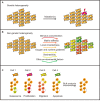Profiling Cell Signaling Networks at Single-cell Resolution
- PMID: 32132232
- PMCID: PMC7196580
- DOI: 10.1074/mcp.R119.001790
Profiling Cell Signaling Networks at Single-cell Resolution
Abstract
Signaling networks process intra- and extracellular information to modulate the functions of a cell. Deregulation of signaling networks results in abnormal cellular physiological states and often drives diseases. Network responses to a stimulus or a drug treatment can be highly heterogeneous across cells in a tissue because of many sources of cellular genetic and non-genetic variance. Signaling network heterogeneity is the key to many biological processes, such as cell differentiation and drug resistance. Only recently, the emergence of multiplexed single-cell measurement technologies has made it possible to evaluate this heterogeneity. In this review, we categorize currently established single-cell signaling network profiling approaches by their methodology, coverage, and application, and we discuss the advantages and limitations of each type of technology. We also describe the available computational tools for network characterization using single-cell data and discuss potential confounding factors that need to be considered in single-cell signaling network analyses.
Keywords: Signaling circuits; assay development; pathway analysis; phosphoproteome; single-cell analysis; systems biology.
© 2020 Lun and Bodenmiller.
Conflict of interest statement
The authors declare that they have no conflicts of interest with the contents of this article
Figures



References
-
- Hetz C., and Saxena S. (2017) ER stress and the unfolded protein response in neurodegeneration. Nat. Rev. Neurol. 13, 477–491 - PubMed
-
- Clapham D. E. (2007) Calcium signaling. Cell. 131, 1047–1058 - PubMed
-
- Pelech S. L., and Sanghera J. S. (1992) Mitogen-activated protein kinases: versatile transducers for cell signaling. Trends Biochem. Sci. 17, 233–238 - PubMed
Publication types
MeSH terms
Grants and funding
LinkOut - more resources
Full Text Sources

